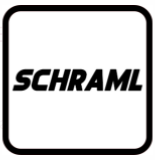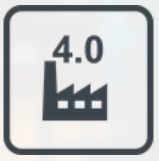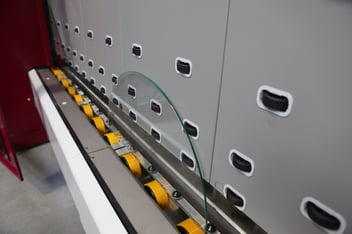Due to the specific properties of laminated safety glass (LSG), a number of factors must also be taken into account when processing this material. After all, the shaped parts not only have to meet very high quality and functional standards, in most cases the aesthetic and visual requirements for the finished products are also extremely high. When cutting LSG, the systems and tools used therefore also play an essential role when it comes to achieving the best results.
In this blog article we deal in detail with what to pay attention to when handling the respective machines and tools.
If the cutting wheel is blunt or has the wrong angle, the best machine won't help.
The three essential tools for cutting LSG are the cutting wheel, the crusher roller and the foil cutting blade. These three must not only be individually in top condition, but must also be optimally matched to each other when they interact. Of course, regular and appropriate maintenance of the individual tools is also necessary in order to be able to cut laminated glass professionally and properly.
1. Cutting wheel
In glass cutting, the cutting wheel is the connection between machine and material and thus the most important component. The following applies in principle: Only the right cutting wheel with the correct angle and well-oiled makes the cut sing - that is, it cuts optimally. It is indeed the case: When the cutting wheel moves cleanly and neatly over the hard glass surface, it is music to the ears of the professional glass cutter. A clean cut is the prerequisite for crushing the glass as desired afterwards. Since cutting wheels also wear out at some point, it is absolutely essential to check them regularly for their condition.
Tip: Our systems automatically record the consumption for each cutting wheel used and indicate when a cutting wheel change is required.
The characteristics of the cuts are divided into Active (A), Basic (B) or Contact Plus (CP) depending on the fineness.
- Active: Cut for Standard and Low-e glass lites sheets
- Basic: Cut for thin glass lites sheets or mirrors
- Contact Plus: Grinding for increased cutting pressures - especially for special shape cutting and trim cutting
In order to prevent a so-called shelling-out of the scoring furrow, it is also important to ensure that sufficient cutting oil is always used and that the angle of the cutting wheel is optimally selected.
The cutting oil fulfils a very special function. Since glass is basically a type of polycrystalline liquid, the micro-fissures that occur during cutting tend to grow together again or “heal”. The cutting oil fills these micro-fissures and prevents this process, so that the glass can then be broken perfectly and with much less force and energy.

In addition, the pressure or cutting force, cutting speed and acceleration must also be adapted to the respective glass.
Here are a few rules of thumb for a clean cut:
- The thinner the glass,
- the more acute the angle (135° - 90°),
- the lower the pressure or cutting force (60 N - 10 N) and
- the finer the cut.
- The thicker the glass,
- the more obtuse the angle (135° - 165°),
- the higher the pressure or cutting force (60 N - 250 N) and
- the coarser the cut.
If all these parameters have been taken into consideration, nothing stands in the way of a beautiful, smooth cutting edge.
Tip: When buying cutting wheels, make sure that they have already been properly run in by a professional! This is because the running-in process will shape the future running meters of each cutting wheel - which of course has a decisive influence on the cutting quality.
Due to our decades of know-how as an original equipment manufacturer, we trust in the Cutmaster Gold carbide cutting wheels from the manufacturer Bohle. These are provided with a titanium nitride coating (TiN coating) and are characterised by an enormously long service life. In addition, they are already retracted and enable a very stable, consistent cutting process.
2. Crusher roller

The crusher roller is used in the next work step of the glass cutting process. This is located directly on the rear cutting head and after cutting the glass is placed on the scoring edge with a certain pressure to crush the laminated glass - this applies: When the crusher roller runs along the top of the laminated glass, the lower glass is crushed - when it runs along the bottom, the upper glass is crushed. One thing is particularly important here: the correct geometry of the crusher roller! This is because it must travel exactly over the crack edge of the glass.
Tip: Use LiSEC crusher rollers. We have continuously developed these over the decades and they therefore have the optimum geometry for every use. And remember: Crusher rollers also wear out and have to be maintained accordingly. In the LiSEC maintenance recommendation (operating instructions), all the necessary details can be found.
3. Foil cutting blade
Last but not least, the PVB foil of the laminated glass sandwich has to be cut. To do this, a foil cutting blade is used which, after the cutting wheels, is the second most important tool for glass cutting. It is particularly important that the foil cutting blade is not only very sharp but also in perfect condition so that the foil is cut cleanly along the edge of the glass and thus prevents what is known as "delamination".
In the worst case, the glass edge can be destroyed if the foil cutting blade is in a poor condition. As part of our commitment to continuous process improvement, we have used all our expertise to find a blade that delivers optimum cutting results while maintaining high durability.

LiSEC therefore relies on a round blade. The advantage: Each blade wears out over the course of a day’s use. In contrast to conventional blades, the round blade can easily be readjusted up to three times and thus sharpened before it has to be replaced.
Tip: After each cut, check whether the foil cutting blade is still in good condition! The LiSEC “Automatic Blade Control” control device helps you enormously, because it automatically reports if the blade is worn or even broken.
Conclusion: Cutting the laminated glass: How the tool affects the glass cutting
If you want to achieve the best results when cutting laminated glass, you not only need professional machines and tools, but you also need to ensure that all components are optimally matched to each other for the respective use and are maintained accordingly. This means that cutting wheels and foil cutting blades must always be sharp and in perfect condition and the crusher roller must have the appropriate geometry.
In the next article we will look at how the design of the machine affects the glass cutting: “The best machines are of little use if the laminated glass does not lie flat on the work surface.”




































